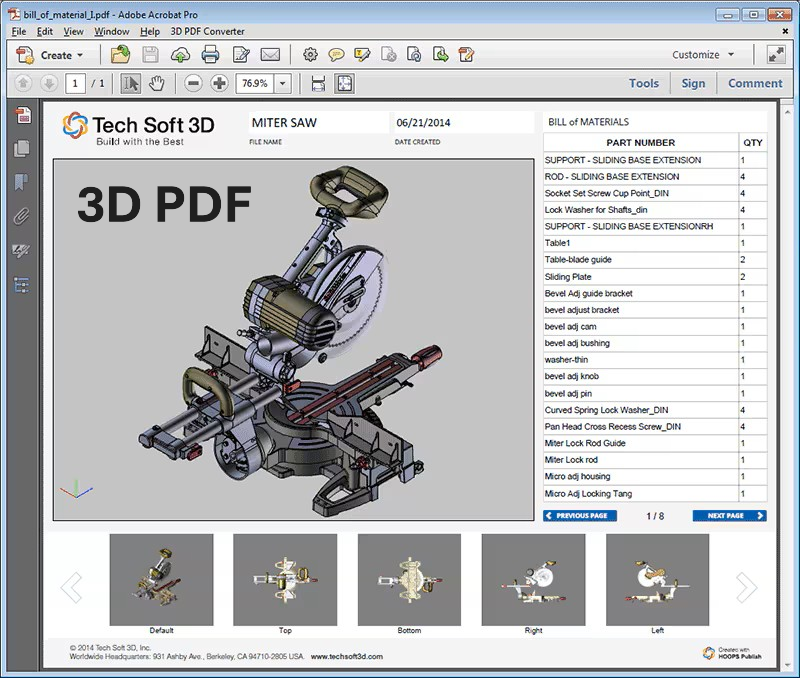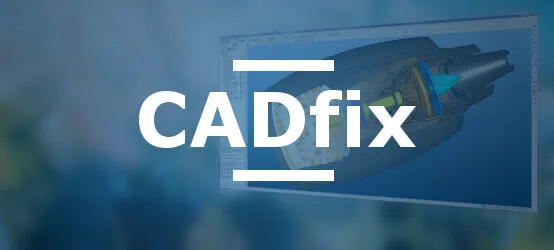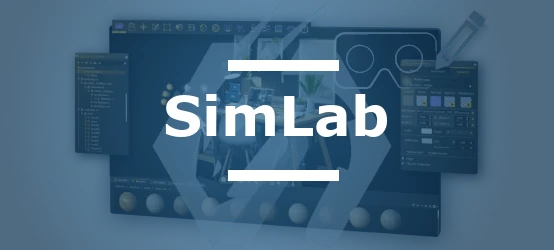
Table of Contents
- History and evolution of 3D PDF format
- 3D PDF for MBD model exchange
- 3D PDF for long-term archiving
- Technical Data Package (TDP) with 3D PDF
- CAD Interop solutions supporting 3D PDF format
- Best practices and interoperability challenges with 3D PDF
- Conclusion and future perspectives
CAD data interoperability is a major challenge for modern industrial companies. In an environment where value chains are increasingly distributed and multi-enterprise collaboration is becoming the norm, the efficient exchange of 3D technical data represents a strategic issue. The 3D PDF format has emerged as a pragmatic solution to this problem by enabling the sharing of complex CAD models in a universally accessible format.
At the intersection of technical communication and engineering, 3D PDF offers a unique balance between functional richness and accessibility. It addresses the fundamental question: how to share sophisticated technical data with stakeholders who may not have specialized CAD tools? This question becomes crucial when design teams need to collaborate with non-technical departments, subcontractors, customers, or regulatory authorities.
The 3D PDF format has several distinctive advantages:
- Interactive visualization of 3D models in a standard document
- Support for Product Manufacturing Information (PMI)
- Accessibility via Adobe Reader, free and widely distributed software
- Integration capability with existing document workflows
- Protection of intellectual data through various security options
This document explores in depth the multiple facets of the 3D PDF format for CAD interoperability, from its technical foundations to its practical applications, including current challenges and available solutions to optimize its use in industrial environments. Beyond the technical aspects, we will examine how this format integrates into business processes and helps streamline information exchange across the entire industrial value chain.
History and evolution of 3D PDF format
The 3D PDF format has revolutionized the way we share and communicate design data across different platforms. This format allows for the integration of 3D models and complex assemblies into a standard PDF file, greatly facilitating sharing and collaboration.
Two 3D file formats can be used to integrate models into a PDF document:
- PRC (Product Representation Compact): Created in 2002 by TTF, it is now published as an ISO standard (14739-1:2014). This format is generally preferred for industrial applications.
- U3D : Defined by the "3D Industry Forum" consortium including companies such as Intel, Boeing, HP, Adobe Systems, Bentley Systems, Right Hemisphere, and others. It offers fewer features than PRC but remains usable for simple applications.
The PRC format has several significant advantages:
- Support for NURBS shape definitions
- Efficient compression of triangular meshes
- Support for annotations, PMI and markups (absent in U3D)
- Compatibility with complex assemblies
- ISO standard status
3D PDF for MBD model exchange
Model-Based Definition (MBD) is a process that includes manufacturing information (annotations, dimensions) directly with the CAD model. The 3D PDF format is an excellent medium for presenting this information in a format accessible to all.
Native support by CAD software
It is important to note that the main CAD software natively supporting 3D PDF export are:
- Creo
- NX
- SolidWorks
- SolidEdge
- AutoCAD
- Inventor
CATIA V5 and 3DEXPERIENCE do not support 3D PDF export as standard, which is regrettable but not unusual for Dassault Systèmes. Third-party solutions can fill this gap.
Comparison of exchange formats for models with PMI
| Format | Graphical PMI | Semantic PMI | Advantages | Disadvantages |
|---|---|---|---|---|
| 3D PDF (PRC) | Excellent support | Good support | Universal format, accessible with Adobe Reader, interactive, supports complex documents, secure | Potentially large size, Adobe Reader update issues |
| STEP | Medium to good support (AP242) | Excellent support (AP242) | Established ISO standard format, mature for data exchange, maximum geometric precision | Requires specific software, less interactive, less visual |
| JT | Good support | Good support | Lightweight format, DMU compatible, ISO standardized, used in automotive | Requires dedicated software, less universal than PDF |
| 3D XML | Medium support | No support | Strong integration with Dassault Systèmes products | Limited mainly to the Dassault ecosystem, less standardized |
For MBD model exchange, 3D PDF stands out for its universal accessibility and ability to integrate interactive PMI annotations in a familiar format. It is particularly suitable for sharing with partners who do not have specialized CAD software.
3D PDF for long-term archiving
For long-term archiving of CAD data, the 3D PDF format has advantages but is generally a second choice compared to the STEP format.
Advantages of STEP for archiving
- ISO standardized format for a long time (ISO 10303)
- Better preservation of exact B-Rep geometry data
- Independence from proprietary software
- Format stability over time
- Better preservation of precise technical information
Complementary role of 3D PDF
Although a second choice, 3D PDF remains relevant for archiving as a complement to STEP:
- Easy visualization of archived models without specialized software
- Possible integration of metadata and contextual documentation
- Ability to include visual representations of PMI
- Standardized format (ISO 14739-1:2014 for PRC)
Best practice often consists of archiving both the STEP format for geometric and technical precision, and 3D PDF for accessibility and visual documentation.
Technical Data Package (TDP) with 3D PDF
TDP concept in CAD data exchange
A Technical Data Package (TDP) is a comprehensive set of technical information necessary to design, manufacture, operate, and maintain a product. In the CAD context, it brings together all elements for a complete understanding of a product.
3Di PDF (interactive 3D PDF) has established itself as an ideal solution for TDPs as it allows for:
- Centralizing 3D models with their annotations (PMI)
- Integrating interactive views facilitating analysis and validation
- Attaching complementary files (STEP, technical documents, etc.)
- Ensuring universal compatibility via Adobe Reader
Advantages of 3D PDF for TDPs
- Universal accessibility : Viewable with a simple standard PDF reader
- Intelligent documentation : Ability to integrate different types of files (PowerPoint, videos, tables) to provide a complete context
- Compliance with standards : Compatible with standards such as MIL-STD-31000B for technical documentation
- Security : Possibility to apply access restrictions and digital signatures
- Portability : Lightweight format facilitating sharing by email
3D PDF perfectly meets TDP needs by offering a standardized container for all types of technical information, accessible to different project stakeholders without requiring specialized software.
CAD Interop solutions supporting 3D PDF format
The ecosystem of solutions offered by CAD Interop provides a comprehensive approach to leveraging the 3D PDF format at every stage of its lifecycle. These tools cover all interoperability needs, from visualization to the creation of immersive experiences, including validation and optimization of technical data.
3DViewStation: advanced visualization and 3D PDF conversion
KISTERS' 3DViewStation represents a versatile solution for working with 3D PDF documents and other technical formats. This platform stands out for its performance and flexibility, available in Desktop and WebViewer versions to meet different access and sharing needs.
Import and export capabilities
- Complete support for 3D PDF formats (PRC and U3D)
- Compatibility with over 40 common CAD file formats, including CATIA, NX, STEP, JT and SolidWorks
- Export capability to 3D PDF from various native formats
- Support for PMI and annotations in conversions
The power of 3DViewStation lies in its ability to not only display but also analyze and interact with complex 3D PDF models. Users can perform measurements, dynamic cross-sections, and model comparisons, then export these analyses to 3D PDF format for sharing. The intuitive interface allows for easy manipulation of views, components, and PMI annotations, facilitating the understanding of technical models even for non-specialist users.
Key features for 3D PDF interoperability
- Fast visualization of large models with performance optimization
- Interactive navigation in assemblies and product structures
- Preservation of PMI and saved views during conversions
- Generation of technical reports in 3D PDF format integrating measurement and analysis data
CADfix: repair and optimization of 3D PDF data
CADfix positions itself as an essential tool for ensuring data quality and reliability during exchange processes in 3D PDF format. This solution addresses one of the major challenges of interoperability: preserving model integrity during format conversions.
Particularly effective for processing complex models from heterogeneous CAD systems, CADfix operates at several levels:
Repair and optimization features
- Automatic detection and correction of geometric problems
- Simplification of overly detailed models to improve 3D PDF file performance
- Geometric "healing" to ensure B-rep surface quality
- Tessellation optimization for an optimal balance between precision and file size
CADfix supports a wide range of CAD formats for import and export, including 3D PDF format, enabling flexible workflows. The solution is available on Windows and Linux, offering batch processing tools to automate conversion and optimization processes.
CADfix capabilities also extend to preparing models for specific 3D PDF use cases, such as generating technical documents, long-term archiving, or creating lightweight digital mockups for visualization and collaboration.
CADIQ: validation and quality assurance for 3D PDF
CADIQ represents the ultimate quality assurance solution in the CAD Interop ecosystem. Specialized in rigorous validation of CAD models, this platform offers unique capabilities to ensure data integrity during exchanges involving the 3D PDF format.
Validation and diagnostic features
- Detection of geometric differences between original and converted models
- Validation of PMI and annotations during conversions to 3D PDF
- Identification of quality issues preventing analysis, manufacturing, or data exchange
- In-depth analysis of geometric and topological properties of models
CADIQ's "3D PDF Viewer Report Module" allows saving diagnostic results in interactive 3D PDF files, facilitating the sharing of validation reports. This feature is particularly useful for documenting design changes (ECO - Engineering Change Orders) and for communicating identified issues to different stakeholders.
CADIQ uses the native programming interface of each CAD system to maximize the accuracy and robustness of analyses. Version 16.5.1 supports a wide range of formats, including 3D PDF (PRC and U3D), and offers specific diagnostics for semantic annotations, PMI attributes, and validation properties.
SimLab: creating immersive experiences with 3D PDF
SimLab significantly broadens the range of possibilities offered by the 3D PDF format by enabling the creation of interactive and immersive experiences. This innovative solution transforms technical data into engaging content for training, education, or marketing communication.
Immersive and interactive capabilities
- Conversion of 3D PDF models to formats adapted for virtual and augmented reality
- Creation of interactive animations from static models
- Development of VR experiences without programming through visual tools
- Support for 18 import formats and 15 export formats
SimLab stands out for its ability to preserve animations and textures during conversions, thus enriching the end-user experience. The solution also allows for the creation of interactive quizzes, assessments, and technical training based on 3D models, ideal for industrial and educational sectors.
Practical applications with 3D PDF models
- Creation of interactive product catalogs
- Development of immersive technical maintenance manuals
- Elaboration of training modules for operators and technicians
- Visualization of complex technical concepts for commercial presentations
SimLab offers different packages adapted to specific needs, particularly for the educational sector with laboratory licenses allowing VR collaboration for up to 30 people per session.
Integration and complementarity of solutions
CAD Interop's global approach to the 3D PDF format is based on the harmonious integration of these four complementary solutions. By combining their respective functionalities, users can set up optimized workflows for the entire lifecycle of 3D PDF data:
- Creation and conversion : Using 3DViewStation to convert various CAD formats to 3D PDF
- Optimization and repair : Applying CADfix to ensure file quality and lightness
- Validation and quality assurance : Deploying CADIQ to verify data integrity
- Communication and user experience : Leveraging SimLab to create advanced interactions
This integrated approach allows companies to fully leverage the 3D PDF format as an interoperability vector, maximizing its value at every stage of the technical data exchange and use process.
Best practices and interoperability challenges with 3D PDF
Recommendations for 3D PDF file exchange
- Model optimization : Simplify overly complex assemblies before conversion
- Compatibility verification : Test files with different versions of Adobe Reader
- Parameter documentation : Note the conversion parameters used to facilitate future exchanges
- Use of PRC format : Prefer PRC over U3D for technical models with PMI
- Inclusion of metadata : Systematically add relevant metadata for the context of use
Known issues and limitations
User forums report several recurring problems with the 3D PDF format:
- Update inconsistency : Adobe regularly modifies 3D support in Reader, sometimes without notice
- Feature removals : Some capabilities have been removed in recent versions for security reasons
- Visualization bugs : Frequent problems correctly displaying 3D models in Acrobat Reader, particularly after updates
- Cross-platform variations : Different behavior between Windows, Mac, and mobile versions
- Security vs functionality : Adobe Reader security settings can block 3D display, requiring specific configuration
Interoperability tips
- Use Adobe Reader version 9.4.1 for better compatibility with older 3D PDF files
- Explicitly enable 3D content in Adobe Reader security settings
- Consider using alternative PDF readers specialized for technical 3D content
- First convert to an intermediate format (such as STEP) before generating the 3D PDF for certain CAD software
- Include a 2D version of the main views as a backup in case of 3D display problems
The 3D PDF format remains a powerful solution for CAD interoperability despite these challenges, thanks to its unique combination of universal accessibility and advanced technical capabilities.
Conclusion and future perspectives
The 3D PDF format occupies a unique position in the CAD interoperability ecosystem. Its dual nature - both an accessible visualization format and a technical container capable of preserving data integrity - makes it a versatile tool for many industrial use cases. Although it does not replace specialized technical exchange formats like STEP for certain critical applications, its universal accessibility allows it to serve as a bridge between the worlds of engineering and corporate communication.
Current challenges related to the 3D PDF format, particularly compatibility issues with recent versions of Adobe Reader and limitations in terms of advanced functionality, highlight the need for a strategic approach to its use. Companies making the best use of 3D PDF are generally those that integrate it into a broader interoperability strategy, combining different formats according to specific needs.
Several emerging trends could influence the evolution of the 3D PDF format:
- Increasing integration with PLM platforms and document management systems
- Development of cloud tools for visualization and annotation of 3D PDF models
- Improvement of bidirectional conversion capabilities between native formats and 3D PDF
- Evolution of standards to meet the needs of Industry 4.0 and additive manufacturing
- Expansion of semantic Model-Based Definition capabilities in the PRC format
For organizations seeking to optimize their technical data exchange processes, 3D PDF remains a relevant solution whose judicious adoption can generate significant gains in terms of efficiency and communication. The key to success lies in a clear understanding of the format's strengths and limitations, as well as in the use of appropriate tools for its creation and management.
As companies continue their digital transformation and the democratization of 3D technologies progresses, the role of 3D PDF as an interoperability vector could strengthen, particularly in industries where technical communication extends beyond the traditional boundaries of engineering. Organizations that know how to integrate this format into a coherent technical data exchange strategy will be better positioned to meet the collaboration challenges posed by modern industry.





